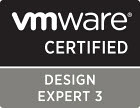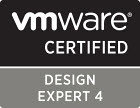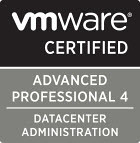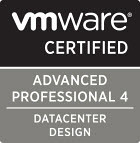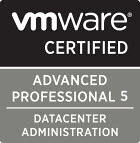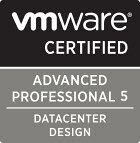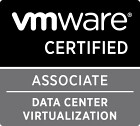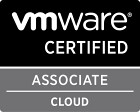I’ve been using Openfiler 2.2 iSCSI in the lab for a few years with great success as a means for shared storage. Shared storage with VMware ESX/ESXi (along with the necessary licensing) allows us great things like VMotion, DRS, HA, etc. I’ve recently been kicking the tires of Openfiler 2.3 and have been anxious to implement partly due to the ease in its menu driven NIC bonding feature which I wanted to leverage for maximum disk I/O throughput.
Coincidentally, just yesterday a few of the big brains in the storage industry got together and published what I consider one of the best blog entries in the known universe. Chad Sakac and David Black (EMC), Andy Banta (VMware), Vaughn Stewart (NetApp), Eric Schott (Dell/EqualLogic), Adam Carter (HP/Lefthand) all conspired.
One of the iSCSI topics they cover is link aggregation over Ethernet. I read and re-read this section with great interest. My current swiSCSI configuration in the lab consists of a single 1Gb VMKernel NIC (along with a redundant failover NIC) connected to a single 1Gb NIC in the Openfiler storage box having a single iSCSI target with two LUNs. I’ve got more 1Gb NICs that I can add to the Openfiler storage box, so my million dollar question was “will this increase performance?” The short answer is NO with my current configuration. Although the additional NIC in the Openfiler box will provide a level of hardware redundancy, due to the way ESX 3.x iSCSI communicates with the iSCSI target, only a single Ethernet path will be used for by ESX to communicate to the single target backed by both LUNs.
However, what I can do to add more iSCSI bandwidth is to add the 2nd Gb NIC in the Openfiler box along with an additional IP address, and then configure an additional iSCSI target so that each LUN is mapped to a separate iSCSI target. Adding the additional NIC in the Openfiler box for hardware redundancy is a no brainer and I probably could have done that long ago, but as far as squeezing more performance out of my modest iSCSI hardware, I’m going to perform some disk I/O testing to see if the single Gb NIC is a disk I/O bottleneck. I may not have enough horsepower under the hood of the Openfiler box to warrant going through the steps of adding additional iSCSI targets and IP addressing.
A few of the keys I extracted from the blog post are as follows:
“The core thing to understand (and the bulk of our conversation – thank you Eric and David) is that 802.3ad/LACP surely aggregates physical links, but the mechanisms used to determine the whether a given flow of information follows one link or another are critical.
Personally, I found this doc very clarifying.: http://www.ieee802.org/3/hssg/public/apr07/frazier_01_0407.pdf
You’ll note several key things in this doc:
* All frames associated with a given “conversation” are transmitted on the same link to prevent mis-ordering of frames. So what is a “conversation”? A “conversation” is the TCP connection.
* The link selection for a conversation is usually done by doing a hash on the MAC addresses or IP address.
* There is a mechanism to “move a conversation” from one link to another (for loadbalancing), but the conversation stops on the first link before moving to the second.
* Link Aggregation achieves high utilization across multiple links when carrying multiple conversations, and is less efficient with a small number of conversations (and has no improved bandwith with just one). While Link Aggregation is good, it’s not as efficient as a single faster link.”
the ESX 3.x software initiator really only works on a single TCP connection for each target – so all traffic to a single iSCSI Target will use a single logical interface. Without extra design measures, it does limit the amount of IO available to each iSCSI target to roughly 120 – 160 MBs of read and write access.
“This design does not limit the total amount of I/O bandwidth available to an ESX host configured with multiple GbE links for iSCSI traffic (or more generally VMKernel traffic) connecting to multiple datastores across multiple iSCSI targets, but does for a single iSCSI target without taking extra steps.”
“Question 1: How do I configure MPIO (in this case, VMware NMP) and my iSCSI targets and LUNs to get the most optimal use of my network infrastructure? How do I scale that up?
Answer 1: Keep it simple. Use the ESX iSCSI software initiator. Use multiple iSCSI targets. Use MPIO at the ESX layer. Add Ethernet links and iSCSI targets to increase overall throughput. Ser your expectation for no more than ~160MBps for a single iSCSI target.
Remember an iSCSI session is from initiator to target. If use multiple iSCSI targets, with multiple IP addresses, you will use all the available links in aggregate, the storage traffic in total will load balance relatively well. But any individual one target will be limited to a maximum of single GbE connection’s worth of bandwidth.
Remember that this also applies to all the LUNs behind that target. So, consider that as you distribute the LUNs appropriately among those targets.
The ESX initiator uses the same core method to get a list of targets from any iSCSI array (static configuration or dynamic discovery using the iSCSI SendTargets request) and then a list of LUNs behind that target (SCSI REPORT LUNS command).”
“Question 4: Do I use Link Aggregation and if so, how?
Answer 4: There are some reasons to use Link Aggregation, but increasing a throughput to a single iSCSI target isn’t one of them in ESX 3.x.
What about Link Aggregation – shouldn’t that resolve the issue of not being able to drive more than a single GbE for each iSCSI target? In a word – NO. A TCP connection will have the same IP addresses and MAC addresses for the duration of the connection, and therefore the same hash result. This means that regardless of your link aggregation setup, in ESX 3.x, the network traffic from an ESX host for a single iSCSI target will always follow a single link.”
For swiSCSI users, they also mention some cool details about what’s coming in the next release of ESX/ESXi. Those looking for more iSCSI performance will want to pay attention. 10Gb Ethernet is also going to be a game changer, further threatening fibre channel SAN technologies.
I can’t stress enough how neat and informative this article is. To boot, technology experts from competing storage vendors pooled their knowledge for the greater good. That’s just awesome!



